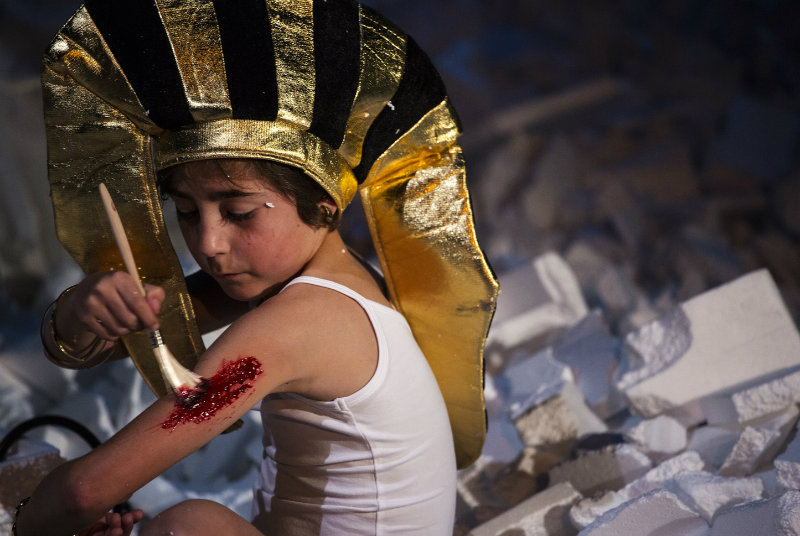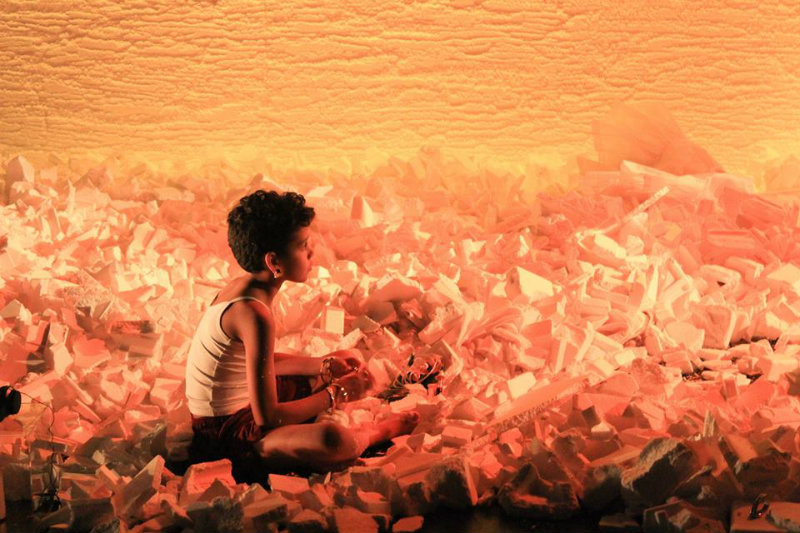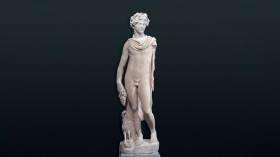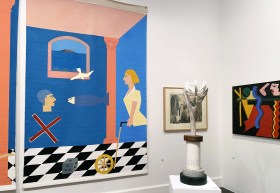(L-R) Josh McElroy, Jeremi Campese and Mia Evans Rorris in ATYP’s Oedipus Doesn’t Live Here Anymore. Image (c) Tracey Schramm.
Even for experienced arts practitioners, working with children and teenagers can come as a challenge if you’re not appropriately prepared for the experience. As well as getting your head around issues like duty of care and pitching your communications at the right level, it’s also important to understand how children think and respond.
As Sue Giles, the Artistic Director of Polyglot Theatre describes it, children and adults essentially live in separate but parallel realities.
‘One of the biggest things I reckon I found out when I started working with kids was the parallel realities that kids live in. They really do live in a different universe. So it’s really everything around that – the culture, the language, the energy, the instincts, the imagination, memory. All of that stuff is affected by the differences in our ages. And that was the most exciting thing I discovered, because that ended up changing everything I did and the way that I made work,’ she said.
‘It made me drop what I knew and change it to something else, so it was a real opportunity to kind of embed myself in chaos and see what came out. To be able to let go of all my learning as an adult practitioner, an artist who knew what they were damn well doing; to let go of that and go “I don’t know anything and I’m going to start again”.
Fraser Corfield, Artistic Director of Australian Theatre for Young People (ATYP) agreed.
‘You can never be presumptuous that you understand what a young person’s experience is, or what they’re thinking, or what their response will be to something,’ he said.
‘I think that’s the greatest mistake that a lot of people make in terms of working with young people. They assume that because they were a teenager once they remember what it was like, therefore they understand where teenagers are coming from. But of course that’s not the case.’
Why work with young people?
Artists who are prepared to embrace the challenges of working with children and young people are sure to find the experience rewarding.
Said Giles: ‘It is one of the areas where you do the most exploration, I reckon. No matter what you’re creating you always are treading into new territory. There’s something that that audience and that set of collaborators that is continually encouraging exploration and new forms – that is if you’re open to what they give you.’
The theatre for young audience sector is one of the most explorative and experimental in the country, Giles believes.
‘And because it’s a really particular cohort I reckon you discover new languages of how theatre can be expressed. And I think that’s because of that parallel universe thing. We live in the same world but we’ve forgotten a hell of a lot of what kids know and they don’t know yet what we do. So there’s this grasping for understanding in the creation of the work that I think is really fascinating as an artist, and as I say, if you’re open to being shifted then you can really be shifted,’ she said.

Junk is the latest touring production by The Flying Fruit Fly Circus.
The energy of and enthusiasm of children – especially those aged eight to ten – makes them ideal partners for creative projects, according to Jodie Farrugia, Artistic Director of the Flying Fruit Fly Circus.
‘I love their sense of play and imagination. To a certain age it’s really easy to tap into. There isn’t a sense of shame or confidence attached to their imagination or play, they can easily tap into it. And I love, I love where their minds go – it’s so free,’ Farrugia told ArtsHub.
Prior to starting work at ‘the Fruities’ (as the company is affectionately known) Farrugia had worked more with teenagers than children. She’s embraced the change.
‘I’ve really grown into that and find it really magic. And in fact I use a lot of the younger kids for the first stage of creative developments of ideas, because even though they might not have the circus skills to choreographically advance the idea, they’ve got this beautiful gold in their minds through their imagination and their playfulness that allows ideas to really come out,’ Farrugia said.
Aesthetics and agency
Theatre-maker Adena Jacobs, whose body of work includes a trilogy-in-process made with children and teenagers (2013’s On the Bodily Education of Young Girls, 2015’s The Bacchae; and 2017’s Book of Exodus, part one of which is playing Melbourne’s Theatre Works until 18 June) said working with children and teenagers is enormously fulfilling.
‘There’s so many reasons for that, and one is about process and about working with people who are not necessarily professional artists; I find it really interesting. And from an aesthetic perspective there is something about the signifier of the child, the signifier of the young person on stage, in relation to time, history and the future and the time of the performance that I find really fascinating.
‘For example in Exodus or The Bacchae you sort of read these young people as channels for these ancient myths or very problematic ideas that we’re passing down to them at the same time as the sense that young people have all this potential and there’s this sense of a future and that they’re in a state of waiting, and so I think that tension is really fascinating,’ she said.
The question of agency also has the potential to help artists create fascinating work when working with young people, Jacobs added.
‘From a directorial point of view these questions of agency I find really fascinating and have fuelled me in a lot of ways. There’s a tension – with any cast but particularly young people – of wanting to be caring and responsible for the artists I’m working with, but at the same time wanting to make work that is challenging and provocative and difficult and pushing the boundaries.
‘And when you’re working with young people and particularly children that tension is magnified and I find that hard but it also produces something so different from what I could produce with adults,’ she said.

Fraught Outfit’s Book of Exodus Part One. Image by Pia Johnson.
What Farrugia calls ‘the brutal honesty’ of children as cultural agents can also benefit the creative process.
‘At that age – eight, nine, ten – I’ve found that they’ll just go, “I reckon that show should have been a bit shorter.” … I think they haven’t got the same social etiquettes that creep in with all that other stuff which is more prevalent in the teenage years, the shame and the too cool for school stuff,’ she explained.
‘They’ve also got this real bluntness because they’re not filtering, they’re thinking. And I find that really refreshing. It’s like, when I work with adults I’d much rather the process be honest and transparent so you can get into some chunky ideas, and really go there. And I do find children refreshing like that, strangely.’
Baby steps
If you’re considering working with children and young people, it’s important not to rush into the decision, and to get the support and training that you need, said Corfield.
‘I think one of the things to be aware of is that just because you’re a professional artist and you understand the industry, it is useful to have a transition into working with young people; to have the opportunity to be developed, mentored, observe or have some sort of connection with someone who is experienced – otherwise the transition can be something of a shock,’ Corfield explained.
‘Most people feel like they’re very experienced as professional artists and therefore they’d love to run workshops with young people but actually there’s some skills in terms of managing a room and ensuring a positive environment, and getting the tone and tenor of the communication with young people right, that is a slightly different skill set from just being a really effective artist.’
Jacobs stressed the importance of trust and respect when working with young people. Like Corfield, she also spoke of the need to work with experienced practitioners when embarking on such productions.
‘Over the years we have been collaborating with Alex Walker, a brilliant youth arts practitioner who has played a central role in the process. Through Alex’s expertise and focus, we are constantly thinking about how to create the most supportive and engaging framework for our performers. Although I have approached the work on this trilogy with the same level of rigour and creative risk that I apply to an adult cast, working with young people does require very particular skills. It has been essential for us to have Alex in the room, and part of the entire process,’ said Jacobs.
Duty of care
Farrugia stressed the importance of being conscious about the fact that you’re working with other people’s children and involving the parents in the child’s creative journey.
‘Particularly in circus, the duty of care and the idea that this is someone else’s child and what that means is so important – not just from a safety level but also at an emotional and a creative level,’ she said.
‘Really it’s about taking the parents on that journey as well. It’s not just about the work you’re doing in the class with that young artist; it’s also about the parents – at the Fruities it’s a 10 year journey so you kind of invest in that relationship with the families as well.
‘So that’s really important, that there’s a sense the parents understand what the child is experiencing, what the child is struggling with, how they can support that at home.’
Jacobs agreed, saying: ‘I think engagement with the parents is really important from the get-go and particularly with devised work. You might not always know actually what the show will be but you can definitely speak to the themes and the questions and maybe even give a list of things that might occur and trust that if those parents or families or guardians are excited by that then they will trust you in the process and continue to keep liaising with them.’

Polyglot’s Cerita Anak (Child’s Story) at Arts Centre Melbourne. Photo by Theresa Harrison.
Then there’s the other side of the duty of care equation, Farrugia said.
‘Having a really good understanding of what is best youth arts practice in terms of duty of care, mandatory reporting, child protection – all of that stuff’s quite big, and I think really important in terms of you remembering that that you have that duty of care in that process – it’s very different to working with adults.’
Echoing Giles’ earlier comments about the support that can be provided by Australia’s cohort of youth arts organisations, Farrugia said it could be valuable to liaise with peers when such conversations were being had.
‘It’s really good to know that you’ve got the right policies and you’ve got the right language with your staff to be able to manage all of that [duty of care] stuff – that you’ve considered anything that might mean the child is vulnerable in a way,’ she said.
‘And I know that sounds a bit doom and gloom but it’s how you do that – I think the best thing that I’ve found is support networks of other artists who are working with young people, or other organisations working with young people. So not reinventing the wheel but just going “hey, have you got a policy for this, for child protection?”
Realistic outcomes
Having a clear picture of what is achievable when working with young people as cultural agents was also an important part of the process, according to Corfield.
‘Young people are capable of creating extraordinarily complex and sophisticated storylines and responses to things, and so as an artist you need to develop the process to understand that,’ he said.
‘The process of sifting through ideas with young people is one thing that takes a little while sometimes. Sometimes when people are working with young people they sit down in a room and say “alright give us your ideas,” and so everyone puts down a whole bunch of ideas – and then they feel that in order to honour it, all those ideas immediately need to land in a production.
‘Whereas in actual fact there is the capacity in working with young people to have the same conversations that you would have in any professional theatre environment. What do we want to achieve? Which ideas service that the best? What ideas get us the most excited? So I think it’s important for artists working with young people to develop a supportive practice that also gives them and the young people they’re working with an understanding of how to sift through ideas to find the best ones rather than accepting everything,’ said Corfield.
Respectful marketing
One easy mistake to make when creating work with children and young people was in the marketing and promotion of the eventual outcome, said Jacobs.
‘You have to be really aware with marketing and framing of the work. It’s one thing to frame something on stage for a live audience who have a context for it; it’s another thing for young people to be represented in the media through marketing and reviews and photos. I think that side of things I’ve had to be much more conscious of, because you are in charge of their image at a young age when they don’t necessarily have control over that themselves,’ she said.
Fraught Outfit’s Book of Exodus Part One.
Creating great work
Every artist ArtsHub spoke with about this topic was adamant that working with children and young people could open up new creative processes and ideas for artists who were willing to commit to such processes.
‘Really, just be open to listening to a different way of seeing the world and not be scared to go into really strong material. Not be scared by any expectations you might have. To start off the process just exploring, just talking, just listening, just observing. And just try and understand the huge area that you can explore,’ said Giles.
‘We get really limited by our expectation of what’s appropriate or sell-able – that’s a big one, what’s going to be accepted by adults who are with the children, and this is particularly true for people who work with children rather than young people, because the gatekeepers for them being part of theatre are many. And they have all the buying power and all the choice around that.
‘So I would say if people are going in, make sure you’re going in with an idea that you are really excited about, that you are going to allow to be affected by the people you’re playing to, or playing for, or playing with. And yeah just be ready to explore as hard and as rigorously as you possibly can. This sector really demands good work, I reckon,’ Giles said.
Jacobs stressed that one of the most important things to remember was ‘to always keep treating the young people as fellow artists and respect them the same way you would [any other artist]. Of course if anyone is interested in working with young people they would be doing that in any case, but it’s really important.
‘And another piece of advice would be you can trust them – I think you can deal with any kind of material you like with young people if you have trust and you have the right framework and if you are honest and open and provide a safety net at all times. You don’t need to shy away. Young people have a perspective on everything – it’s just about creating the right space for that to occur in and to not hold back with them,’ Jacobs added.
Farrugia emphasised the important of remembering that the process is not about you but about the young people you’re making work with and for.
‘I think what I’ve had to do, as a personal choice for me, is go “this isn’t about me.” And particularly because [the Flying Fruit Fly Circus] is a training institution, it’s about process; always thinking about how you can teach or nurture the young artists,’ she said.
‘So this isn’t about me as a professional artist making work on adults that I want to make – there’s an element of that, because we all need that in our practice, but there’s also an element of “I’m actually teaching someone here and I’m taking them through a process and I’m challenging them.” So it’s also about having a good understanding of the educational process, I reckon; how kids learn, how they retain information, the psychology of education in children, I think’s really important for people to know.’
Corfield stressed that working with young people was ‘incredibly rewarding’ – especially for them.
‘When you work with artists who work professionally all the time, you have a good experience, sometimes you make great shows and sometimes you don’t. But when you’re working with young people, if you create an effective relationship, you create an experience that those young people will retain for the rest of their lives. The rewarding nature of that – it really can’t be underestimated,’ he concluded.
ATYP’s Oedipus Doesn’t Live Here Anymore is playing at ATYP Studio 1, The Wharf until 24 June 2017. Details at www.atyp.com.au.
Directed by Adena Jacobs, Book of Exodus – Part I is playing Theatre Works, St KIlda until 18 June 2017. More information at theatreworks.org.au.
Visit www.polyglot.org.au for details of upcoming performances by Polyglot Theatre.
The Flying Fruit Fly Circus’ Junk plays Sydney Opera House from 5-16 July 2017 and Arts Centre Melbourne from 20-23 September 2017. Details at fruitflycircus.com.au./strong>







